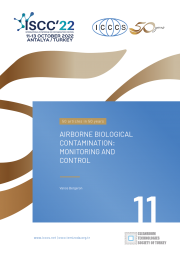AIRBORNE BIOLOGICAL CONTAMINATION: MONITORING AND CONTROL
Authors:
Vance BergeronKeywords:
airborne, contamination, biological contamination, monitoring, controlAbstract:
Airborne Biological Contamination includes a vast range of particulate and molecular species that present specific challenges for monitoring and control. In particular, the notion of viability places restrictions onsample collection and analysis. Furthermore, controlling airborne levels of microorganisms requires technologies capable of inactivating and/or chemically eradicating them, as simple capture onto filter media
can lead to proliferation and subsequent release. The advent of new assay capabilities using rapid microbiological methods in combination with effective air sampling techniques holds promise for future
online monitoring systems, while combinations of different technological bricks can be used to tailor air-treatment systems to remove, inactivate and chemically transform particulate, biological, and molecular
airborne contamination.
Article:
1. Introduction
What is Airborne Biological Contamination (ABC) ? The response to this question depends on the environment and the activities that are to be carried out therein. In a hospital environment disease causing
pathogens are of most concern, while in the microelectronics, food processing and pharmaceutical industries a host of different types of particulate matter of biological origin, not necessarily complete
organisms (e.g. toxins and biological waste products), may create problems with product reliability, efficacy and toxicity. Taking this into consideration, the reformulated question generally becomes: What is the
Airborne Biological Contaminate of Concern ?, and once answered will then dictate how to measure, monitor and treat the air for the presence of the specific target contaminate. In what follows we will focus
on complete micro-organisms not their fragments or byproducts. When considering airborne micro-organisms (e.g. bacteria, viruses, fungi) one of the primary classifications used for charactering them is to
determine whether or not they are viable. However, here again questions arise as to what is meant by viable. General definitions of viable include; capable of working, functioning, or developing adequately,
sustainable or capable of growing, able to germinate and reproduce. This in turn has fostered a wide range of terms to describe the state of microorganisms, such as, dead, moribund, starved, dormant, resting,
quiescent, viabile but non-culturable, injured, sublethally damaged, inhibited, resuscitable, living, active, and vital (1,2). Kell et. al. provide an extensive discussion of these terms and subsequently propose
useful operational definitions that assign cells into four major categories as combinations of two alternatives: (1) culturable or nonculturable and (11) (metabolically) active or inactive, noting that a clear
distinction should be made between cells that are not immediately culturable (NIC) from those which are simply nonculturable.
These various notions for characterizing airborne microorganisms necessitate different experimental assays and tools to ascertain their level in the environment. Indeed basing the definition of viability on, that which
requires continuing existence of the species to survive, as lead to the ability of cells to reproduce as the benchmark method for determination of viability. For this reason the most common analysis method used is
plate counting from appropriately selected culture media. However, over the last decade there has been an increasing interest in the development of rapid microbiological methods (RMM) for the determination of
cell viability, such as; Adenosine TriPhosphate (ATP) detection, impedance measurements, CO, generation, and auto-fluorescence. In addition to these, a variety of nucleic-acid-amplification methods such as
polymerase chain reaction (PCR), which are very sensitive assays for detecting the presence of DNA, have emerged. These rapid microbiological method technologies can provide more sensitive, accurate and
reproducible test results when compared with conventional growth-based methods (3)
 Click to Download PDF
Click to Download PDF

